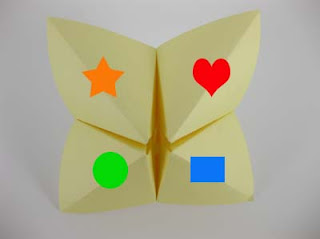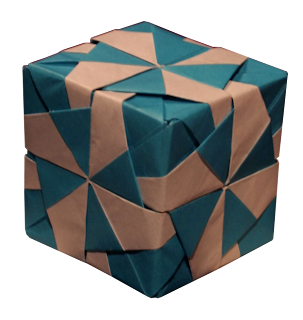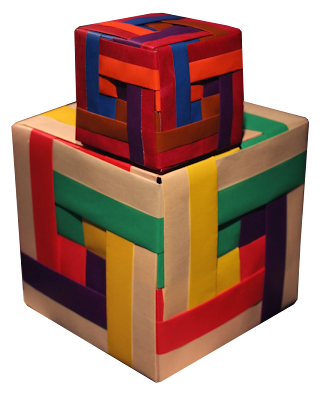Origami Fortune Teller on NBC's Community
Recently we posted our video on how to use the origami fortune teller.
The NBC comedy show " Community " uses the origami fortune teller in a unique way; to show the opening credits. Very neat, and a very funny show as well.
Here is a link to the trailer for Community .
Oie!!!
Vim divulgar que saiu o resultado do sorteio do blog de papéis!!
Se tiverem interesse em saber quem ganhou, acessem:
http//tchami-papel.blogspot.com
Bjaummm...
One Last Heinz Strobl Snapology Project
As much as I've enjoyed folding Snapology models by Heinz Strobl, I had planned to move onto something else to keep up a little variety. However, I had the idea of making the small Icosahedron models to give as a reward/incentive to a class of 11-year olds that I team-teach in church. We had a program in which all of the primary-aged children had speaking and singing parts. All of the children did a fantastic job, but I was particularly proud of my class. I had a blast making the models and loved the reaction from each of the kids when they got them. I had contacted each of their moms to find out their favorite color and used that as the main color for each of them. Something that I found especially amusing was that of the nine kids (there was five boys and four girls) eight of them said their favorite color was either blue or green (or a variation of one of those colors, like turquoise). I thought for sure one of the girls would have said purple. Despite that, I like the several color variations that were created. By the time I had finished all of them I only had time and light to take one group picture of them. I was very pleased with all of them, but my favorite color combination is the dark blue and yellow that is second from the left in the bottom corner.
| The group picture of Heinz Strobl's Snapology Icosahedron models I made for my Primary class I lead at church. |
I made this animation about a year ago, and I wanted to share it with you guys because the drawing style is so similar to my comics.
Check out our Facebook page.
More Heinz Strobl Snapology Models
Here are the rest of the Snapology models that I folded. In my last post about the largest model (the Truncated Icosidodecahedron) I stated that I didn't use any glue (which I didn't), however some of the smaller models required it. I used glue dots (which my wife so graciously offered to let me try and which I depleted rather quickly :) to hold the tabs down on some of the models for aesthetics sake. My favorite models are the larger ones that required no glue.
| The whole collection. |
| Another shot of the entire collection smallest to largest. |
| A close-up shot of the Dodecahedron (12-sided) model; I had to use glue on some the sides of this model. |
| My second favorite model, the Icosahedron (20-sided) model. |
| The Truncated Cube model. This is one of the models that I had to use glue to hold together. |
| This is the Truncated Cuboctahedron model. |
| Another shot of the first Icosahedron. I love the size. |
| Here's a shot giving a comparison of the different models. |
Oie!!
Estou fazendo um sorteio no meu blog de papéis...
Participem!! ^^
http://tchami-papel.blogspot.com
Bjaum....
Oie!!
Essa bonequinha fofa foi a Sayuri que ensinou num encontro do Orisampa.
Lindinha, né??? Até o rostinho, ela mandou para podermos imprimir... ^^
Ela ensinou uma outra também, mas anda não tirei a foto...
Bjaum...
origami magic rose cube by valerie vann+instructions
Heinz Strobl's Snapology Project
Something I love about origami is being able to watch paper start at such a plain and basic form that we use everyday and become something so much more incredible and beautiful. I recently decided to try my hand at something that I'd found on the Internet a while ago, Snapology. I was surprised at how simple the technique is and how the results look. The models don't take much time to actually fold, so before I knew it I had tried nearly a dozen of them; each one of them a little larger than the one before. I decided to try a very large model and document each of the steps. Here they are:
| It starts with plain copier paper that you can find at any store that carries office supplies. |
| The paper is then cut into strips of a predetermined width (these are 1/2 an inch). |
| The strips of paper are then cut to specific lengths for the model that has been chosen. At this point there are about 180 of the small strips of blue paper. |
| And now for my favorite part of any modular or unit origami model: the assembly. I started with a decagon (10-sided) and attached squares and hexagons alternately to it. |
| From there I added 5 more decagons with the necessary squares and hexagons in between. |
| After that an additional 5 decagons are added for the next layer of assembly. |
| Finally the last (and 12th) decagon is added to complete the model. |
| Another shot of the final model to give a little perspective. It's roughly the size of a softball. |
The model I used is known as a Truncated Icosidodecahedron for anyone as geeky as myself that wants to know. It's comprised of 12 decagons (10-sided), 20 hexagons (6-sided), and 30 squares. I didn't actually clock how long it took me to cut, fold and assemble, but I estimate it was a solid couple of days total. Obviously this is the one that took the longest because its the largest. Something to note here is that there is no glue holding it together. The only cutting that was done was to get the strips, after that it was just folding and assembling.
The link to where I found instructions are here. The site is in both English and Polish. The instructions aren't the most clear (it's obvious that English is not the author's first language) but still sufficiently detailed and has good pictures as a guide. The rest of the site is very impressive, with fantastic pictures of models that they've folded and lots of diagrams for other models.
Another site that has instructions about origami strip paper folding is here. I've done another model from here that I love, the Sphere 94. The original creator of Snapology is Heinz Strobl. If you get curious about some of the other things that he has created simply type his name into a search engine for images and you'll find some very impressive pictures. I absolutely love that origami can be found so plentifully on the Internet at no charge; this hobby can truly be an inexpensive one. Having said that I still absolutely love my small collection of origami books that have taught me so much. Enjoy the pictures. I will post again soon the rest of the Snapology models that I folded.
Origami Best Seller
Popular
-
In one of my previous posts about origami sonobe balls I posted a picture of how I had used some of the balls that I had folded as Christmas...
-
One of the things that I'd like to do with this blog is feature the work of the many different artists that I enjoy. I'd like to pu...
-
Pentru Kusudama Spring (autor: Akemi Ueda) aveti nevoie de 30 de patrate din hartie (recomand dimensiunea de 7 cm) si de lipici. Modulele se...
-
If you want to impress your friends with a simple cube that becomes a rose in front of your eyes...... Here you have it! It is challenging a...
Archive
-
▼
2010
(405)
-
▼
Oktober
(65)
- Cheer Up
- Hipsters
- pinwheel cubes by Kunihiko Kasahara
- pinwheel modules for cubes by Kunihiko Kasahara
- thatch cubes + folding instructions
- Origami Fortune Teller on NBC's Community
- Help I've Fallen and I Can't Get Up!
- Papusi japoneze
- Roommates
- Resultado do sorteio!!
- One Last Heinz Strobl Snapology Project
- Avatar
- Animated Short
- Apples to Apples
- whirl dodecahedron by Meenakshi Mukerji
- Refrigerator Drawings
- Ed Hardy Intervention
- The 5 Stages of Facebook
- How to Get People to Like Your Music
- Flexible ball
- Origami Instructions is now on Facebook!
- More Heinz Strobl Snapology Models
- Sorteio no outro blog!! ^^
- Robin Hood
- Bonequinha... ^^
- origami magic rose cube by valerie vann+instructions
- Prop 19
- Spanish and German
- sonobe cube
- sonobe module
- Heinz Strobl's Snapology Project
- License Agreement
- Dubstep 102
- Kusudama Morning Glory si Curler
- Nudist Colony
- Quer fazer uma troca?
- Calatoriile a doi cocori prin Milano
- Bayer da culoare vietii!
- Lalele
- Origami Fortune Teller or Chooser
- Dollar Menu
- Dubstep 101
- Skynet
- Extreme Trustfall
- THE BLUE SHELL!
- truncated icosahedron
- Note to Self...
- Care Package
- Nintendo Headquarters 1992
- rhombic icosahedron/dodecahedron
- Easy Origami Tortoise
- Facebook Official
- Drive Pies
- Origami Instructions now on Twitter!
- News
- Fresh Attitude
- Vasectomy
- Expozitie de origami ADOR in Cluj - Atelier
- True Story
- Un cocor mai marisor
- Un cocor mai marisor
- Expozitie de origami ADOR in Cluj - Atelier
- How To Be a Badass
- De volta ao trabalho mesmo.
- The List
-
▼
Oktober
(65)






















